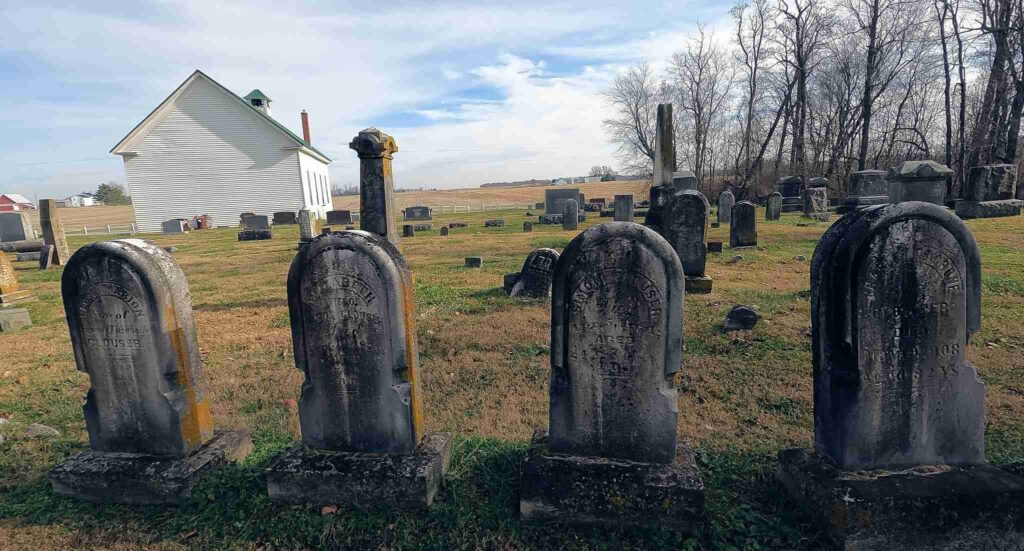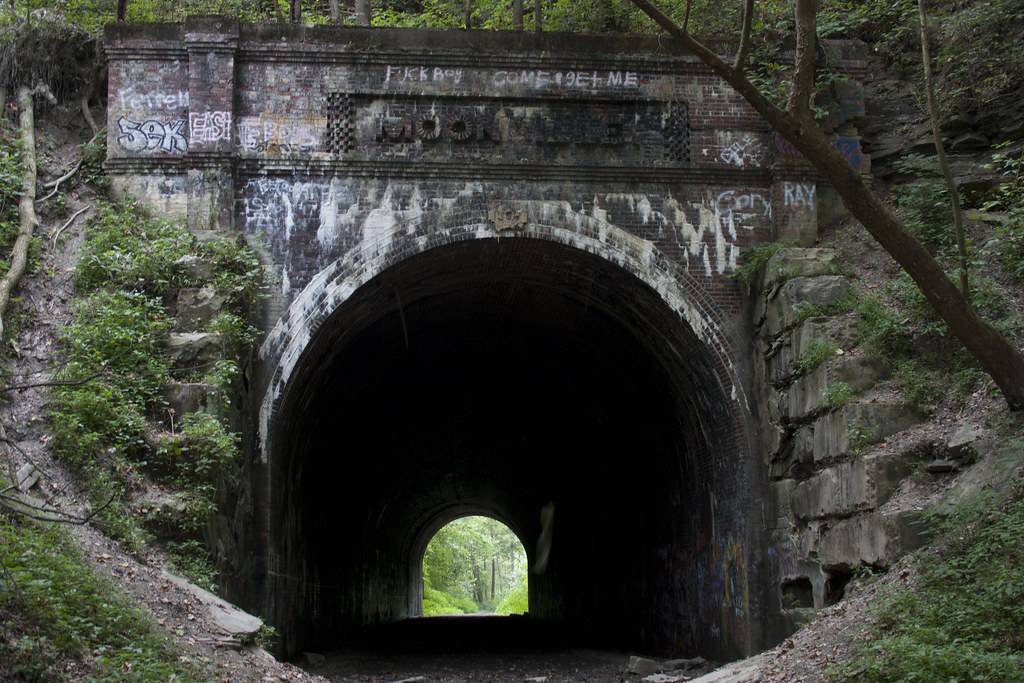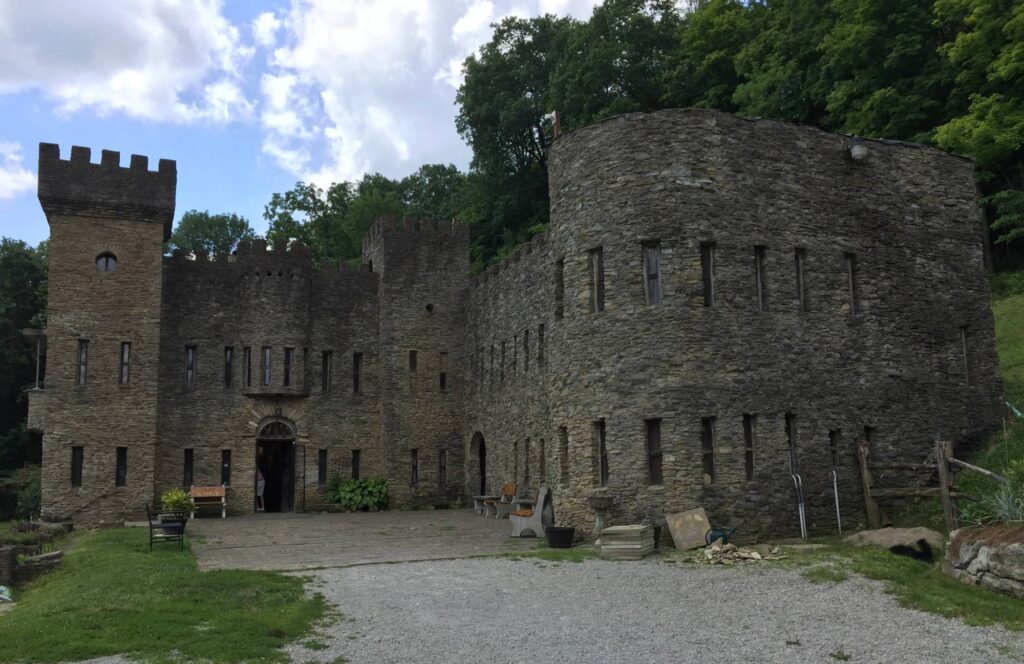When it was first settled in the mid-1880s, many people had thought or hoped the village would soon prosper. And, for a short time, it did. The town’s first settlers, Simon and Elizabeth Clouser moved in and set up a mill, which was in demand at the time for there weren’t any other mills in the immediate vicinity at the time. Before long, it had a store … then a stone quarry, and it looked as if the town was headed in a good direction … except …
In a letter dated January 7, 1872, Theophilus Von Puff (who was a real person and definitely not a Disney Villain) begins by praising the community of Fallsville, stating it has a population of 2,000 people, saying how twelve buildings had been built in the previous year and suggesting that a lot more were on the way. He notes the natural beauty of the surrounding area, the morals of the town’s current inhabitants, citing the local Quaker church, the Odd Fellows, the Sons of Temperance as well as the Rooms of the Y.M.C.A. as signs of the town’s promise.
The town’s principle manufacturing business (as he called it) were the mills, which he said “probably exceeds” not just production quantity but also quality as compared to all the other mills in the county.
The purpose of the letter was an attempt to attract a railroad. At the time, Railroads were already making their way to other small towns in Highland County, which seemed to prosper greatly afterwards. Fallsville was doing everything it could think of to attract a railroad, such as publishing the Von Puff letter, building a rail depot, and essentially doing everything they could to attract one.
But, sadly, that never came to be. By the turn of the 20th century, everything the town had been known for seems to have all but died off. Where the nearby newspapers used to report all sorts of activity in and around Fallsville, by then it was little more than real estate transfers and notices of nearby road work. The only thing of any real value that was noted was the Fallsville Fall, the picturesque waterfall that the town had been named after.

Today, the town of Fallsville is rather hard to find on the map. The whole town and much of the surviving area has now been taken over by the Fallsville Wildlife Area and is known today for its hiking trails and, um, wildlife, I guess. And, of course, the waterfall, which I hear is still lovely. You can still visit the Auburn Community Church and its cemetery which is easily accessible via Careytown Road. Beyond that, little remains save a few building foundations here and there, with little to hint at what these structures might have once been or who used them. But, mostly Fallsville has been reclaimed by nature.
Beyond that, only myths and legends remain.
There are those who believe that certain town residents were witches – casting spells, practicing magic, and acting really really weird. (Actually, that last part is undeniably true, but acting weird doesn’t make you a witch, so there is that..) There are those who believe that on certain days out of the year, you can spot the spectral form of a Native American girl walking through the woods looking for … um … something, I guess. Likewise, the spirit of an older Native American man is making his rounds, too … which may or may not be connected to the legend that says there is a missing cache of riches buried somewhere in or near Fallsville.
Aside from one particular stunning waterfall, Fallsville does not seem to get the love and attention it probably deserves. In light of all the myths and legends associated with the area, it’s easy to dismiss the town as just another ghost town, a place that once existed but is no more. Nothing of major historical value seemed to happen there, so why should we care?
Well, when you start to look at it, you’ll probably come to realize that Fallsville, and some of its residents, were actually damn interesting.
The Clouser Family
Among the town’s first settlers were the Clousers. This family consisted of the father, Simon; and the mother, Elizabeth (maiden name Duckwall). Shortly after moving to Ohio, their first son Nelson Duckwall was born in 1819, followed by his sister Charlotte in 1826. The next two boys Lewis and Samuel were born in 1832 and 1836 respectively. The final child, daughter Susannah, came along in 1837.
The Clouser name must have carried some weight around Fallsville and the surrounding communities. Shortly after moving to the area, Simon and Elizabeth opened the town’s mill, which was said to have produced the best quality flour and meal in the county. The mill was also, likely, the town’s biggest employer and it stands to reason that before long the Clousers were the richest family in Fallsville.
Some people claim that the Clouser family were witches. While this claim had been made indirectly (never officially) there are still those today who still want to believe it’s true. Some of this may stem from the family’s wealth as some jealous townsfolk tried to ponder why this family seemingly had it all while others struggled – surely some dark magic or something must be involved.
However, it’s more likely a reaction to those who found the family to be a bit weird. Ok, they were rich enough – I can call them “eccentric”. And, quite possibly, that might be a bit of an understatement.
To be fair, the wealthy having odd habits or interests is nothing new. However, stories like this are usually confined to the larger cities, places more like Chicago, New York City, or Los Angeles and a bit less like a small town with a few thousand residents. Yet, this does happen, and here is a great example of that.
There are two stories that have been told (and appeared in print) that certainly shine a curious light on the Clousers.
The first, dated around 1866, appears to be more a story of a few warring newspapers (and even daring each other into a fight). It all started when one newspaper, The Highland News, printed a story about a wealthy Copperhead who refused to give some breakfast to some weary Union soldiers who were traveling through the area. Another paper, The Gazette, reprinted this story, but also begged the News to reveal who the wealthy Copperhead was. The following week, the News did just that – stating that the individual in question was, in fact, Simon Clouser.
A third paper, The Democrat, seemed to take a rather large offense to this, saying that the Highland News was defaming an elderly soldier and his family for no reason. They claimed to know the story was false and demanded an apology. In the August 2, 1866 edition, the Highland News made it clear they had no intention of doing such. In essence, The News claimed they were reporting what was told to them by a Mr. Jacob Holmes, who operated a nearby farm and who did, in fact, give breakfast to the traveling soldiers. He claimed not to remember the soldiers names, only that they were from the town of Marshall.
The Gazette now claimed that they had been contacted by Simon Clouser to print that the story was false and that no such thing happened. He (Clouser) claimed that he was not even at home at the time, although his wife Elizabeth was. Elizabeth was also strongly concerned with the recent outbreak of Pox that had been going around and suggested that if such an event had occurred, then maybe it was his wife who turned them away, scared of contracting Pox.
The second event occurred in 1901. By now, both Clouser parents have passed away and only two of the family’s daughters, Charlotte and Susannah remained on the family’s 200 acre farm. At the time, their brother Simon had relocated to New York City where he made his own fame and fortune. That day, in 1901, Samuel came to Fallsville planning on spending a few days with his sisters. The three are believed to have spent a wonderful afternoon together after he arrived, but as night was approaching the sisters informed their brother that he would need to find lodging somewhere else. They explained that since their father’s death, no man had slept in the family home, period. And, as long as they were alive, no man ever would again.
Or, at least, this was the story as it was first reported.
The September 26, 1901 edition of Hillsboro’s News Herald painted a vastly different picture.
According to the sisters, their brother had, indeed, come to town and stayed with them for several nights. Also, on one of those nights, the sisters planned a big dinner party for him and several of his childhood friends who still lived in the area, listing their names. As if to offer further proof, they finally claimed that their brother had sent them essentially Thank You Gifts, including an expensive watch chain for one sister, and a fine watch for the other. He also sent along a set of silverware for the household and a bible he asked to be given to the local church the family had attended. Charlotte, however, claimed the bible, which cost fifty dollars, was too expensive of a gift to leave unattended at the local church, so she kept it herself to protect it from vandals and thieves.
A side note here … there is another curious thing about this column. In the introductory paragraph, the writer states that the sisters lived on a farm near “what used to be Fallsville”, indicating that by the year 1901, the town was, essentially, no more.
It is hard to say for certainty which version of this story holds more truth. After all this time, we may never know if the brother was turned away for the night because the sisters would allow no man to sleep in the house after their father’s death … or, if the brother had stayed with them a few nights and sent along some wonderful gifts to show his gratitude.
What does seem certain, though, is that it seems many Highland County residents seemed to believe it. The girls were known as essentrics, so that could explain it, at least to a small degree. It does make me wonder, though, what other strangeness the two girls had gotten up to that wasn’t necessarily reported in the papers.
If someone did make up that story, on the other hand, I have to ask “Why?” What did he (or she) stand to gain? Did they have a beef with the girls, or the family? Is there part of this story that is still yet untold?
The Fallsville Treasure And A Murdered Native Man And A Native Girl?
According to legend, there is a treasure buried somewhere around Fallsville. The details of the story all depend on who’s telling it, but by most accounts, the story goes something like this.
One Christmas Eve, a Native American was running through the Fallsville area, trying to escape a small possey of white dudes that for some reason wanted him dead. Some say Mr. Indigenous had killed a white family and stolen their valuables, and the men chasing him were their friends and neighbors trying to bring the man to justice and trying to recover the stolen property. Another version has the Native being pursued by white men who only wanted his treasure or money and were willing to do anything to get it.
The legend continues by the treasure somehow being buried somewhere in, or around Fallsville. Some claim the Native American man buried it so he could flee his pursuers and come back for the treasure later, only he was murdered and nobody could find the treasure after that. Others claimed that the men who killed him buried it so they could come back for it later, but they never did. What these tales all seem to have in common is that the treasure got buried and is probably still out there, and someone murdered the Native American guy.
The Legend continues even further because all good legends need to feature a ghost or two, I guess. According to the legend, many people who live around Fallsville have been claiming that every Christmas Eve, someone or something knocks on their door around nightfall. Some say it’s the native american man looking to show the occupants where the treasure is … and some claim it’s the native american girl looking for something, either the final resting place of the native american man who supposedly was her father, or maybe she wants to take you to the treasure, too. Other people claim to have seen a native american girl’s ghost roaming the area as if she were looking for something.
The details of all these legends might be fun stories to tell, but it’s hard for me to believe any of it ever happened. There is no record anywhere that suggests a native american murdered a white family and stole all their belongings. There are no records anywhere to indicate that a native american had been killed in the area. In almost all version of the story, multiple people were involved and certainly there would be something, somewhere, to lend some historical accuracy to any of it.
But, oftentimes, legends do contain at least a small bit of truth, so perhaps there is buried treasure somewhere out there around Fallsville. I just highly doubt it has anything to do with murdered native americans or a mob from a nearby town.
The Clousers And The Treasure
Another version of the buried treasure story brings things back to the Clouser family.
There are some who have tried to suggest that the treasure was buried well before Simon and Elizabeth Clouser moved to Fallsville. This time, the couple are looking at land around Fallsville when they stumble upon the buried treasure. This gives them the sudden uptick in wealth they needed in order to buy the mill in the first place … while a slightly different version say they found it on their property and this explains how they came into as much money as they did.
Finally, a more nefarious version I’ve seen but a single time suggests that it was Mr. Clouser who cornered the Native American man and killed him, burying the loot somewhere on his property where, supposedly, it remains to this day.
The Clouser Mysteries Continue
The more I learn about the Clouser Family, the more questions I find myself having.
For example, there is a grave in the Auburn Cemetery (the only cemetery in Fallsville and where most of the Clousers are buried) that is simply attributed to “Child Clouser”. What I can’t find any record of is who this child might have been. Clearly, the child died at or around birth, which would explain why he or she was never given a name. Considering that Charlotte and Susanna, the only two Clouser daughters, never seem to have gotten married, this would suggest that Elizabeth miscarried one of Simon’s children and had it buried in a simple grave behind the church. But, is that what really happened?
We also know that Nelson got married to a woman named Mary and that the couple lived in Indiana where they raised a family and he worked as a doctor. At some point, he got married twice more. I have found nothing to suggest Nelson ever set foot in Fallsville once he left. Lewis seems to have left Fallsville, also. At the age of 18, according to the Census he was living and working a few miles away as a clerk. Sadly, the documentation I’ve seen ends there.
That leaves us with Samuel. We know he headed east to either Pennsylvania or New York where people claimed he was rather successful. A couple of Ohio newspapers later referenced a Mrs. Samuel Clouser, so we’re relatively certain he had been married, however when that happened, or if the two had any children is still unknown.
In this family, we know the eldest son, Nelson, went on to have children, and it is entirely possible that Samuel did as well. But, what of Lewis?
Both the Clouser girls, Suzannah and Charlotte, never married and in a way that is a curious fact, too. Combine that with the story of how they forbid their brother to sleep in the house after their father’s death, and the way that some of the fellow Fallsville residents described them as odd, it makes me wonder if there is another story here as well.
And, is it possible that the Child Clouser buried at the local cemetery is actually one of theirs? While that is doubtful, I still have to wonder if it’s possible.
Charlotte Clouser passed away in 1908 after battling an illness. Her sister, Susan, the last remaining member of the family passed away a few years later, in 1914. Susan, now in her 80s, was found dead laying at the bottom of the stairs in her home by a neighbor. No signs of foul play were discovered, so it is believed that she somehow fell down the stairs and immediately died.
However, there was one final secret that Susan held onto that would come as a shock to at least a few people, including her brother Nelson’s four living children (Mary Elizabeth, Robley, Lydia, and Charles) as well as their brother Samuel’s daughter Flora. Had Susan died without leaving a will (and nobody before her death had reason to believe she had one) the Fallsville property and house, as well as any wealth would be split between the five nephews and nieces. So, it came as a surprise when a will did show up, leaving a few small bequests to various individuals, but the rest of the property (valued at the time as over $3,500.00, which was no small sum) went to one Dr. V B McConnaughey – leaving any and all of her relatives with absolutely nothing.
Yet another mystery befell the Clouser family in 1886 when their house was burned to the ground. It is impossible to tell how thorough the investigation was, but it was fairly clear the Clouser Sisters thought that a colored man named Andrew Peyton (who, it just so happened, they had previously parched some of their land from) was responsible and he was rather quickly arrested for the crime. At trial the prosecutor barely laid out any evidence against the man at all. After proceedings were handed over to the defense, Peyton’s attorney offered evidence that called all the prosecutors’ evidence into question. For example, leading to and from the site of the arson, a complete set of horse tracks were discovered. When Peyton’s attorney called the town’s ferrier to the stand, he stated that the day before the fire, he had worked on Peyton’s horse, which when he was finished was only wearing three shoes. Therefore, Peyton’s horse could not have left a complete set of tracks. Also, witnesses were brought to the stand to testify that Peyton had al alibi in the hours before the fire started, and additional witnesses to say that he had taken a route home that would not have taken him near the Clouser house.
When the trial was over, the Judge had some stern words for the prosecutor. He noted not only the vaguely circumstantial case, but also how during the trial, the prosecutor did not attempt to dispute any evidence, nor did he even attempt to cross examine a single witness. The judge told him that if he was unable to defend the charges brought against the man, they shouldn’t have been brought at all. Needless to say, the jury did not find the colored man guilty.
Fallsville – A Short But Oddly Interesting History
As I was doing research for this article, I was pleasantly surprised by the amount of historical information I was finding when going through old newspaper reports for a small town that only existed for a short amount of time.This, of course, consisted of me sifting through a ton of mundane information on things like announces of road or bridge building, estate or land transfers, and of course brief mentions of social gossip, like how Seymour Buttz had dinner with his cousin Drew P. Wiener on Friday.
What I did find that was the most surprising, however, was how nearly everything I was finding somehow connected to The Clouser Family. Not all of them … but by far the vast majority. In a way, this isn’t surprising since the family operated the mill, which was the town’s largest business. Many of the other townsfolk were mentioned in the papers, and not just in the land transfers or gossip columns, but in a variety of other articles as well, usually something like listing the names of teachers at the local schoolhouses or a few words on the temporary excitement concerning a cow that had wandered off.
From nearly every account I’ve read, the Clouser family (and in particular the two sisters) were an odd bunch, and that might help explain why so much of the town’s history seems to center around them.
Even forgetting that particular family – there is still something about the town of Fallsville that captures the imagination and wants to make itself known. The town has occasionally appeared in novels, such as one from the lovely author (yes, I have met her, and yes, she was lovely) Debbie Williams whose book For The Love Of Fallsville is a perfect example.
Let’s Go To Fallsville?
For just a moment, let’s forget that Fallsville was ever a town. Let’s forget its history, as well as the various myths and legends associated there.
Today, the Fallsville Wildlife Area is a rather popular destination for locals and travelers, especially those into hiking, hunting, fishing, or birding. (Because hunters are known to roam the area, it might be a good idea to wear bright clothing and leave your deer costumes at home.)
The Auburn Community Church and the Auburn Cemetery may also be of interest.
And, according to everybody I know who has seen it, it’s definitely worth a trip just to see the falls, even if nothing else.
Dig Deeper!
- Fallsville Wildlife Area – Official Ohio Department of Natural Resources
- Fallsville Wildlife Area – All Trails
- For the Love of Fallsville: The Story of a Highland County Ghost Town – by Debbie Williams (Fiction) ASIN : B0BBQ9ZV63; ISBN-13 : 979-8848015928



